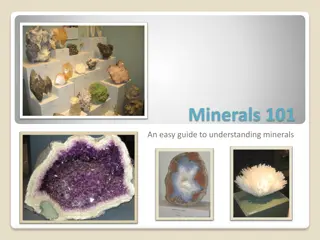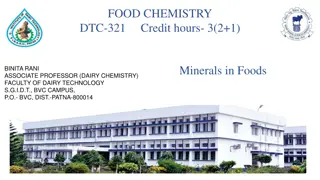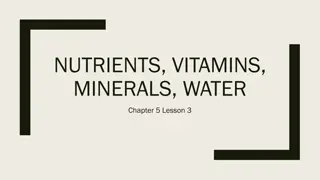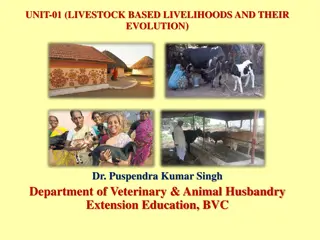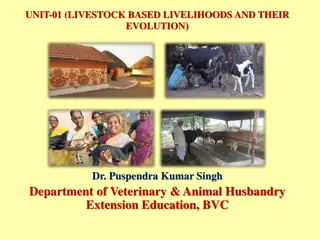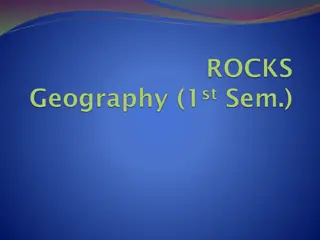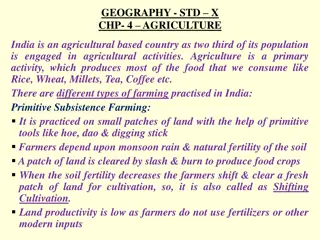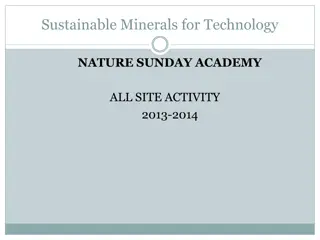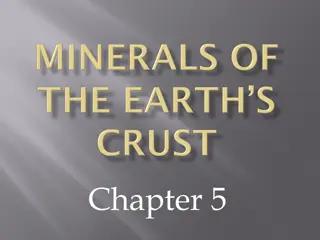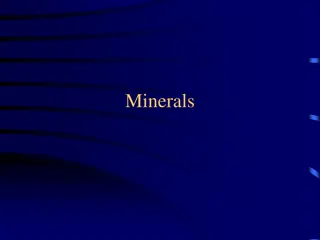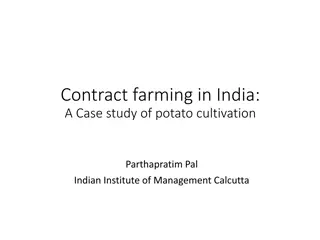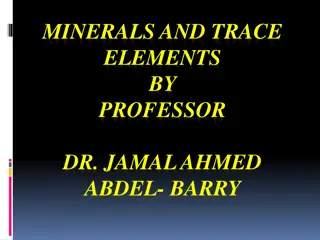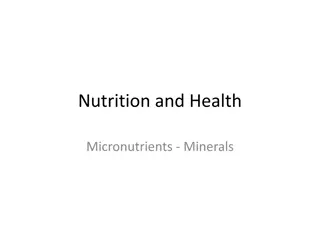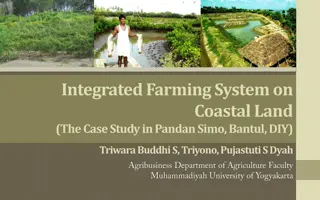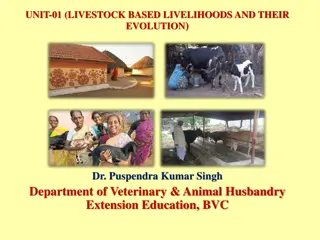Plant Minerals and Farming Methods
Learn about how plants use minerals for growth, the role of nitrates, different leaf tissues, mineral deficiencies, and farming methods to ensure crop yield. Discover how plants obtain minerals from the soil, symptoms of mineral deficiencies, and the importance of fertilizers in farming. Explore different farming methods and their impact on increasing crop yield.
Download Presentation

Please find below an Image/Link to download the presentation.
The content on the website is provided AS IS for your information and personal use only. It may not be sold, licensed, or shared on other websites without obtaining consent from the author. Download presentation by click this link. If you encounter any issues during the download, it is possible that the publisher has removed the file from their server.
E N D
Presentation Transcript
Plant Minerals Progress Indicators: Describe how a plant uses minerals Explain the role of nitrates in plant growth Do Now Activity: Describe the roles of the following tissues found in leaves: spongy mesophyll layer, palisade mesophyll layer, epidermis.
What minerals do plants need? For healthy growth, plants need four important minerals: Nitrates Phosphates Potassium Magnesium Question: How do you think plants receive the minerals they need?
Question: How do you think plants receive the minerals they need? Plants obtain minerals from the soil. The minerals are dissolved in water, this is then taken up by root hair cells and then transported around the plant via the xylem vessels.
Mineral Deficiencies https://www.youtube.com/watch?v=QALxEt6OFpc Task: Watch the video and outline the main symptoms in plants for the following mineral deficiencies: a) Nitrate deficiency ~ b) Phosphorous deficiency ~ c) Potassium deficiency ~ d) Magnesium deficiency ~
Self-assessment: a) Nitrate deficiency ~ Plants have older, yellow leaves and poor growth. b) Phosphorous deficiency ~ Leaves look a purplish colour, poor root growth. c) Potassium deficiency ~ Leaves begin to yellow at the edges with dead patches appearing. d) Magnesium deficiency ~ Plant leaves will turn yellow.
Farming Methods Farmers employ different farming methods to ensure the best crop yield. When farmers harvest their crops, mineral ions are stripped from the soil. These need to replaced, so one important farming method is the use of fertilisers. NPK fertiliser is most commonly used this contain Nitrate, Phosphorous and Potassium.
Task: Draw a table with the following headings: Farming method How does this help to increase crop yield? Different people have different information on farming methods, look at slides 12 and 13 to ensure you have a description of each 6 in total
Self-assessment: Farming method How does this help to increase crop yield? Fertiliser Replenishes soil with mineral ions after crops have been harvested, for new crops to flourish. Pesticides Kill insect pests which would damage crops, by reducing insect pests you ensure more crops can survive to full growth. Herbicides Kill broad-leafed weeds which would compete with the crops for sunlight and nutrients. This gives the crops the best chance to survive and grow. Machinery Clears land so there is more space for crops to grow, also use of machinery is faster than humans for planting and harvesting crops. New plant varieties New plant varieties, with more favorable characteristics for the environment they live in, often provide greater yields. Greenhouses Provide a controlled environment for plants to grow, this means optimum conditions can be maintained: warmth, sunlight and water.
Mineral Deficiency: Information for Farmers Task: Produce a pamphlet of information which could be given to farmers to help them decide which mineral their plants could be missing. You should include images (diagrams) of a healthy plant, as well of unhealthy plants depicting the various mineral deficiencies.
Plenary WhatsApp message Write a WhatsApp message to your friend telling them what you have learnt this lesson!!
Resources Resources
Machinery Forests and hedgerows are cut down in order to clear more land ready to be used for crops. This also makes it far easier for larger machinery to move around the fields, machines can plant, and harvest crops faster than humans can. Pesticides Pesticides kill pests these are organisms which damage crops. Insecticides kill insect pests. Both of these help to protect the crops from damage, which will increase the yield. Herbicides Herbicides kill weeds, these would usually compete with the crops for water, light and mineral salts. Modern herbicides are selective, meaning that they only kill plants with broader leaves but leave plants with narrow leaves.
Fertilisers Fertilisers contain mineral salts, such as nitrates, phosphorus, potassium and magnesium ions. Most farms use a mixture of natural (animal waste) and artificial fertilizers. The mineral ions are needed to replenish the soil after harvest ready for new crop growth. Greenhouses Greenhouses can bs used to make sure that plants have the best conditions for growth. This means that you can control the warmth, light and water given to plants is carefully controlled. Plant Varieties Scientists create new varieties of plants by genetic engineering or by making hybrids, by crossing two different types of plants with favorable traits. These new varieties now have a greater yield than others.



